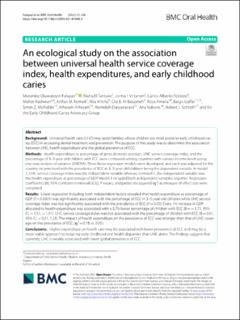An ecological study on the association between universal health service coverage index, health expenditures, and early childhood caries
Folayan, Morenike Oluwatoyin; El Tantawi, Maha; Virtanen, Jorma; Feldens, Carlos Alberto; Rashwan, Maher; Kemoli, Arthur M.; Villena, Rita; Al‑Batayneh, Ola B.; Amalia, Rosa; Gafar, Balgis; Mohebbi, Simin Z.; Arheiam, Arheiam; Daryanavard, Hamideh; Vukovic, Ana; Schroth, Robert J.
Journal article, Peer reviewed
Published version

Åpne
Permanent lenke
https://hdl.handle.net/11250/2768853Utgivelsesdato
2021Metadata
Vis full innførselSamlinger
- Department of Clinical Dentistry [479]
- Registrations from Cristin [10412]
Sammendrag
Background
Universal health care (UHC) may assist families whose children are most prone to early childhood caries (ECC) in accessing dental treatment and prevention. The purpose of this study was to determine the association between UHC, health expenditure and the global prevalence of ECC.
Methods
Health expenditure as percentage of gross domestic product, UHC service coverage index, and the percentage of 3–5-year-old children with ECC were compared among countries with various income levels using one-way analysis of variance (ANOVA). Three linear regression models were developed, and each was adjusted for the country income level with the prevalence of ECC in 3–5-year-old children being the dependent variable. In model 1, UHC service coverage index was the independent variable whereas in model 2, the independent variable was the health expenditure as percentage of GDP. Model 3 included both independent variables together. Regression coefficients (B), 95% confidence intervals (CIs), P values, and partial eta squared (ƞ2) as measure of effect size were calculated.
Results
Linear regression including both independent factors revealed that health expenditure as percentage of GDP (P < 0.0001) was significantly associated with the percentage of ECC in 3–5-year-old children while UHC service coverage index was not significantly associated with the prevalence of ECC (P = 0.05). Every 1% increase in GDP allocated to health expenditure was associated with a 3.7% lower percentage of children with ECC (B = − 3.71, 95% CI: − 5.51, − 1.91). UHC service coverage index was not associated with the percentage of children with ECC (B = 0.61, 95% CI: − 0.01, 1.23). The impact of health expenditure on the prevalence of ECC was stronger than that of UHC coverage on the prevalence of ECC (ƞ2 = 0.18 vs. 0.05).
Conclusions
Higher expenditure on health care may be associated with lower prevalence of ECC and may be a more viable approach to reducing early childhood oral health disparities than UHC alone. The findings suggest that currently, UHC is weakly associated with lower global prevalence of ECC.
